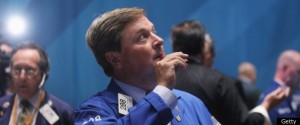Updated October 7th, 2018
What is A stock market or equity market?
A Stock Market or equity market is public (a loose network of economic transactions, not a physical facility or discrete entity) for the trading of company stock (shares) and derivatives at an agreed price; these are securities listed on a stock exchange as well as those only traded privately
Estimation of the World Stock Market
The size of the world stock market was estimated at about $36.6 trillion at the start of October 2008.[1] The total world derivatives market has been estimated at about $791 trillion face or nominal value, 11 times the size of the entire world economy.
The Value of the Derivatives Market
The value of the derivatives market, because it is stated in terms of notional values, cannot be directly compared to a stock or a fixed income security, which traditionally refers to an actual value.
The vast majority of derivatives ‘cancel’ each other out (i.e., a derivative ‘bet’ on an event occurring is offset by a comparable derivative ‘bet’ on the event not occurring). Many such relatively illiquid securities are valued as marked to model, rather than an actual market price.
Where Stocks are Traded?
The stocks are listed and traded on stock exchanges which are entities of a corporation or mutual organization (Brokers) specialized in the business of bringing buyers and sellers of the organizations to a listing of stocks and securities together.
The largest stock market in the United States, by market cap, is the New York Stock Exchange, NYSE. In Canada, the largest stock market is the Toronto Stock Exchange.
Major European examples of stock exchanges include the London Stock Exchange, Paris Bourse, and the Deutsche Börse (Frankfurt Stock Exchange).
Asian examples include the Tokyo Stock Exchange, the Hong Kong Stock Exchange, the Shanghai Stock Exchange, and the Bombay Stock Exchange. In Latin America, there are such exchanges as the BM&F Bovespa and the BMV.
Who Can Participate in the Stock Market?
Participants in the stock market range from small individual stock investors to large hedge fund traders, who can be based anywhere. Their orders usually end up with a professional at a stock exchange, who executes the order.
Some exchanges are physical locations where transactions are carried out on a trading floor, by a method known as open outcry.
This type of auction is used in stock exchanges and commodity exchanges where traders may enter “verbal” bids and offers simultaneously.
The other type of stock exchange is a virtual kind, composed of a network of computers where trades are made electronically via traders.
Actual trades are based on an auction market model where a potential buyer bids a specific price for a stock and a potential seller asks a specific price for the stock.
(Buying or selling at market means you will accept any ask price or bid price for the stock, respectively.) When the bid and ask prices match, a sale takes place, on a first-come-first-served basis if there are multiple bidders or askers at a given price.
The purpose of a stock exchange is to facilitate the exchange of securities between buyers and sellers, thus providing a marketplace (virtual or real). The exchanges provide real-time trading information on the listed securities, facilitating price discovery.
The New York Stock Exchange.
The New York Stock Exchange is a physical exchange, also referred to as a listed exchange – only stocks listed with the exchange may be traded.
Orders enter by way of exchange members and flow down to a floor broker, who goes to the floor trading post specialist for that stock to trade the order.
The specialist’s job is to match buy and sell orders using open outcry.
If a spread exists, no trade immediately takes place.
In this case the specialist should use his/her own resources (money or stock) to close the difference after his/her judged time.
Once a trade has been made the details are reported on the “tape” and sent back to the brokerage firm, which then notifies the investor who placed the order.
Although there is a significant amount of human contact in this process, computers play an important role, especially for so-called “program trading”.
The NASDAQ
The NASDAQ is a virtual listed exchange, where all of the trading is done over a computer network. The process is similar to the New York Stock Exchange. However, buyers and sellers are electronically matched.
One or more NASDAQ market makers will always provide a bid and ask price at which they will always purchase or sell ‘their’ stock.
The Paris Bourse
The Paris bourse now part of Euronext, is an order-driven, electronic stock exchange.
It was automated in the late 1980s. Prior to the 1980s, it consisted of an open outcry exchange.
Stockbrokers met on the trading floor or the Palais Brongniart. In 1986,
the CATS trading system was introduced, and the order matching process was fully automated.
From time to time, active trading (especially in large blocks of securities) have moved away from the ‘active’ exchanges. Securities firms, led by UBS AG, Goldman Sachs Group Inc. and Credit Suisse Group, already steer 12 percent of U.S. security trades away from the exchanges to their internal systems.
That share probably will increase to 18 percent by 2010 as more investment banks bypass the NYSE and NASDAQ and pair buyers and sellers of securities themselves, according to data compiled by Boston-based Aite Group LLC, a brokerage-industry consultant.
Now that computers have eliminated the need for trading floors like the Big Board’s, the balance of power in equity markets is shifting.
By bringing more orders in-house, where clients can move big blocks of stock anonymously, brokers pay the exchanges less in fees and capture a bigger share of the $11 billion a year that institutional investors pay in trading commissions as well as the surplus of the century had taken place
Source of information



